edit
Rainwater harvesting is the process of effectively collecting, storing, and utilizing rainwater within the area where precipitation occurs, employing various techniques. As the fundamental component of all water resources, rainwater can be captured and stored through different applications, with the main distinctions among these methods lying in the ways water is collected and preserved. Traditionally, rainwater has been gathered primarily in reservoirs located away from urban centers; however, contemporary practices emphasize the use of urban and rural areas—including rooftops and permeable surfaces—as water catchment zones. In this context, roofs, pavements, and open spaces serve as sources for water supply. Rainwater harvesting supports the local conservation and management of the water cycle by processes such as slowing down, spreading, and infiltrating water into the soil. This method facilitates the circulation of water within ecosystems and contributes to sustainable water resource management.

Rainwater Harvesting System (Generated with Artificial Intelligence)
Historical Development
Throughout history, various civilizations have utilized rainwater harvesting for drinking and agricultural purposes. In ancient Egypt, approximately four thousand years ago, storage tanks with capacities ranging from 200 to 2000 cubic meters were constructed. In Thailand, rainwater collection techniques dating back around two thousand years exist. During the Roman era, since 2000 BCE, roof catchment systems were used to collect rainwater for both potable and utility purposes. In Africa and Asia, simple water channels and earthen vessels have been widely employed for rainwater collection. Specifically in Türkiye, numerous underground cisterns were built for water supply, particularly in Istanbul. Prominent examples include the Basilica Cistern (Yerebatan Sarayı) with 336 columns, the Binbirdirek Cistern (Pileksenus) with 224 columns, and the Acımusluk Cistern. The use of cisterns in the basements of residences and palaces in the Historical Peninsula became widespread due to insufficient water resources to meet the population's needs. These historical practices demonstrate continuity with modern rainwater harvesting techniques.
Application Techniques
The primary methods used in rainwater harvesting include:
- Roof-Based Rainwater Collection Systems: Rainwater is collected from rooftops via gutters, filtered through screens that retain large particulates, and directed into storage tanks. The stored water can be used domestically for laundry machines, toilet flushing, and garden irrigation.
- Underground and Surface Storage Systems: Rainwater is stored either in subterranean tanks or surface basins and made available for use when needed.
- Soil Covering (Mulching): Covering the soil surface with organic materials such as grass clippings, straw, or dry leaves helps preserve soil moisture and reduces evaporation.
- Rain Gardens: Areas layered with permeable materials and planted with vegetation are designed to promote infiltration and retention of rainwater, thereby reducing surface runoff and enhancing soil water capacity.
In Türkiye, under the “Green Building Concept,” the use of rainwater collected from rooftops for fire water reservoirs, landscape irrigation, and toilets has become increasingly common. For instance, at the Diyarbakır Solar House, rainwater collected from roofs is filtered and used for garden irrigation and toilet reservoirs. Research conducted at Sakarya University campus has indicated that rainwater harvested from roof areas can satisfy a significant portion of the irrigation demand for green spaces.
Rainwater Harvesting Case Study (WWF)
Calculation of Rainwater Yield
Rainwater yield is a key indicator used to estimate the volume of rainwater that can be collected from a given area. The yield is calculated using the following formula:
Rainwater Yield = Catchment Area × Annual Rainfall × Roof Coefficient × Filter Efficiency Coefficient
Where:
- Catchment Area: Typically the surface area of a building’s roof.
- Annual Rainfall: The average yearly precipitation amount, based on data from the General Directorate of Meteorology.
- Roof Coefficient: According to the German DIN 1989 standard, set at 0.8 to account for the fact that not all rainfall on the roof can be captured.
- Filter Efficiency Coefficient: According to DIN 1989, set at 0.9, reflecting losses during filtration of particulates.
For example, with a roof area of 100 m² and an average annual rainfall of approximately 632 mm in Istanbul, the volume of harvestable rainwater is estimated to be about 45 cubic meters.
Türkiye's Water Status and the Importance of Rainwater Harvesting
Globally, only 2.5% of total water is freshwater, and approximately 70% of this freshwater is locked in glaciers and ice caps. The accessible freshwater constitutes less than 1% of total water resources. Türkiye is among the countries experiencing water scarcity, with an annual per capita water availability of approximately 1,519 cubic meters. Due to population growth, this figure is projected to decline to 1,120 cubic meters by 2030.
While the average daily per capita water consumption in Türkiye is around 216 liters, the indirect or “virtual” water consumption embedded in production processes reaches approximately 5,416 liters per day. For instance, producing a cotton T-shirt requires about 2,500 liters of water, a hamburger 2,400 liters, and a cup of coffee 130 liters. These figures highlight the urgent need for efficient and sustainable water management practices such as rainwater harvesting.

Rainwater Harvesting System (Generated with Artificial Intelligence)
Benefits and Ecosystem Impacts
Rainwater harvesting provides substantial environmental, economic, and social benefits within the framework of sustainable water management. Key advantages include:
- Conserving natural water sources and enabling low-cost water supply by collecting a renewable resource—rainwater.
- Supporting soil vitality and vegetation growth, thereby enhancing soil quality.
- Acting as an effective strategy against drought and preventing soil erosion.
- Reducing flood and inundation risks caused by excessive rainfall.
- Increasing the resilience and sustainability of agricultural lands, pastures, and forest ecosystems.
- Contributing to the preservation of historical and cultural heritage by sustaining environmentally sensitive structures.
- Supporting rural development by improving agricultural irrigation possibilities.
- Enhancing microclimatic conditions by increasing local humidity and providing cooling effects.
- Offering multi-dimensional contributions—environmental, social, and economic—to climate change adaptation.
- Improving local access to freshwater and strengthening water supply security.
- Presenting low-cost, easy-to-implement, and widely adoptable solutions for diverse communities.

Rainwater Harvesting System (Generated with Artificial Intelligence)
Legal Framework
In Türkiye, to promote and standardize rainwater harvesting, relevant provisions were enacted in 2017 under the “Regulation on Planned Areas Zoning” (Planlı Alanlar İmar Yönetmeliği). These regulations set technical conditions and implementation principles for the collection, storage, and use of rainwater. Furthermore, municipal bylaws and technical standards issued by the Ministry of Environment, Urbanization, and Climate Change provide guidance for managing rainwater harvesting applications. Rather than a standalone regulation, rainwater management in Türkiye is addressed through this comprehensive body of legislation and standards.


